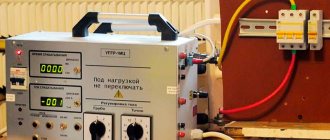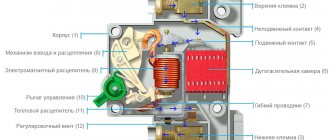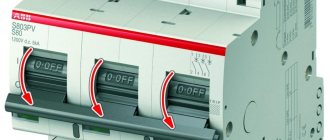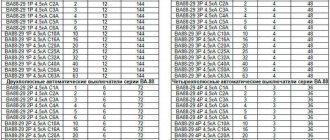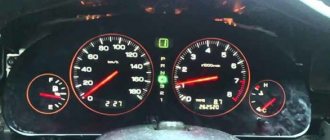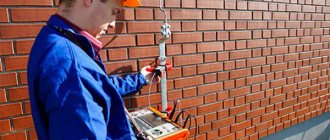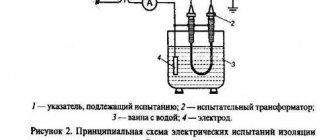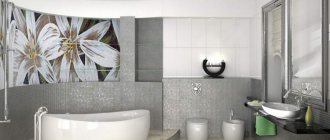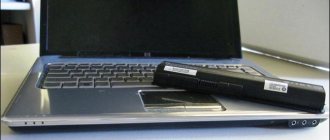Circuit breakers (CBs) are components of the electrical network that perform the switching function in the circuit and serve to conduct current and open when the indicators deviate too much from the nominal values up or down. Safety regulations require that such equipment operate reliably and that the risk of malfunction is reduced to zero. For the purpose of testing, a procedure is carried out to determine how correctly the switch functions. The process is called loading the machine; the results must be documented. They are drawn up by specialists based on the indicators obtained during testing; the finished protocol for testing circuit breakers must be certified by the seal and signatures of the compilers.
Employees of a company that has a license for this type of activity have the right to test and create a document.
Regulatory documents
Accepted verification methods are used to measure the period of time during which the protective device operates and to establish compliance of the identified values with the requirements of the GOST R 50571.3-94 standard. According to this regulation, the shutdown time should be no more than 5 seconds when the grounding resistance is less than the indicator calculated by the formula (50/U0) x Z0. In it, U0 is the nominal phase value, and Z0 is the zero phase.
The preparation of a technical report with the results is carried out in accordance with the provisions of GOST R 50571.16-2007.
When is RCD testing required?
- Diagnostics must be carried out before putting the electrical installation into operation (acceptance), after its overhaul (post-repair), during the period between repairs (periodic), in case of failure of the protection device (unscheduled) or as prescribed by the supervisory authorities.
Frequency of checking residual current devices
- According to clause 28.7 of Appendix 3 of PTEEP, RCD testing must be performed at least once every three months.
The procedure for testing according to the RCD test method
- A set of organizational and technical measures is being implemented to ensure the safety of work (defined by POT R M-016-2001).
- The completeness of the technical documentation is checked, which should include: a certificate confirming the device’s compliance with GOST R 51356-1-99, an instruction manual, and accompanying documentation.
- The validity of the choice of RCD protection zone and the correct location of the device in the electrical installation diagram are assessed.
- The fixation of the control element of the tested residual current device is checked.
- The performance of the RCD is tested (a five-time trip test with the operating voltage turned on).
- After assembling the test circuit, direct measurements of the operating parameters of the RCD are carried out (starting current, contact voltage, active grounding resistance, response time)
- By comparing the values obtained as a result of measurements with the nominal characteristics of the device specified by the manufacturer, a conclusion is made about its suitability for further operation.
How are the results of RCD tests recorded?
- After carrying out the entire set of measures to diagnose the condition of the device, the customer receives a technical report, which includes a protocol for testing the RCD (drawn up in accordance with the requirements of GOST R ISO/IEC 17025-2006), a description of the methodology used, and copies of the permitting documentation of the electrical laboratory.
- If inconsistencies are identified, the customer is given recommendations on how to eliminate them.
Protocol for inspection and testing of automatic circuit breakers controlled by differential current (RCD)
Inspection and testing protocol for automatic circuit breakers controlled by differential current (RCD), page 2
Inspection and testing protocol for automatic circuit breakers controlled by differential current (RCD), page 3
Inspection and testing protocol for automatic circuit breakers controlled by differential current (RCD), page 4
Inspection and testing protocol for automatic circuit breakers controlled by differential current (RCD), page 5
Inspection and testing protocol for automatic circuit breakers controlled by differential current (RCD), page 6
Inspection and testing protocol for automatic circuit breakers controlled by differential current (RCD), page 7
Advantages of the mobile electrical laboratory "SK "OLIMP"
- The list of types of work to which our electrical measuring laboratory is authorized allows, in addition to testing (checking) residual current devices (RCDs), to carry out comprehensive diagnostics of the compliance of electrical equipment and electrical installations with voltages up to 35 kV with the requirements of PUE, PTEEP, RD and SO instructions.
- The issued inspection reports are accepted by all regulatory authorities.
- Guarantee of accuracy and reliability of tests - timely verification of measuring instruments, strict adherence to measurement methods, competence of personnel (measurements are carried out by employees with electrical safety clearance group V).
- Each customer is included in the database of regular customers and receives a discount the next time they contact or order from others.
When is a protocol needed?
This document on testing machines with power up to 1000 V is drawn up during testing. They, in turn, are performed in the following cases:
- Commissioning of electrical equipment or a building in which electrical communications are laid.
- Regular checks during operation in accordance with regulations.
- Upon completion of scheduled or emergency repairs of electrical installations, including major ones.
- As a result of troubleshooting equipment malfunctions.
- As part of tests carried out to prevent serious accidents.
What does the RCD test report look like?
A mandatory element that such documentation contains is information about the device used for the examination. In particular, the name and manufacturer, as well as the date of the last state verification and registration number are entered in the RCD test report. It is also necessary to indicate in accordance with the requirements of which regulatory document the inspection was carried out - these can be standard PUE, PEETP, as well as industry rules for the operation of electrical devices. In addition, internal regulations of enterprises that are officially registered and have full force, taking into account current legislation, may also be indicated here.
When commissioning of electrical equipment or inspection according to plan is carried out, the RCD must be subjected to a comprehensive study. In particular, the protocol provides for indicating the magnitude of the operating current for all three phases in combination with the neutral. Also, the RCD test report must include the names of the lines on which the devices are installed and the types of devices according to the common classification. If you need to view such a document, you will find it in this article.
Contents of the document and nuances of drafting
Circuit breaker test report form
A report must be drawn up based on the results of each test carried out annually. Devices that are used to measure voltage and response time are required to undergo timely verification, the results of which are confirmed by the presence of a certificate. Persons who meet a number of requirements are allowed to fill out:
- Completion of training in special courses and successful certification, based on the results of which a group of 3 and above was assigned.
- The specialist responsible for the work has a 5th category, the team members - from 4th.
- The team consists of at least 2 people.
Based on the test results, the operability of equipment and networks is determined, the operation of which is associated with a great risk to human life and health. That is why it is not recommended to trust the work to non-professionals.
Rheostat check
This is the most effective way to test a residual current device. From the elements described above - a lamp, a resistor and wires - we actually assemble an RCD parameter meter. You only need to add a rheostat and an ammeter (a multimeter turned on in current measurement mode).
A rheostat is an electrical element that allows you to smoothly adjust the resistance, due to which the current strength also smoothly changes.
An example of such a device is an ordinary dimmer (dimmer), which many people install instead of a push-button switch for an electric lamp.
By changing the resistance, the dimmer regulates the luminous flux. For us, it will regulate the current strength.
To assemble the circuit, connect a dimmer, a 2 kOhm resistor, a 10 W lamp and a multimeter in series with copper wires.
To securely fix the multimeter contacts, use terminal strips or alligator probes.
Turn the tester into ultra-low current measurement mode. Connect the circuit to the RCD contacts as described above and change the resistance by smoothly rotating the dimmer vernier. A working device will turn off, and the tester will show the real value of the leakage current at which it worked.
How to fill out the protocol
At the top of the document on the right, information about the customer, the object under study, and the time of verification are indicated. On the left side, fill out a field with information about the electrical laboratory conducting the tests (name, certificate number, data and validity period of the license). In the title of the act, indicate the document number, the conditions for the procedure and the purpose, then fill out a table where the following information is entered:
- Switch number.
- Place on the diagram, markings.
- Type of action of releases.
- Rated current.
- Response delay.
- Setpoint.
- Overload current and short circuit testing.
Below you can see a completed sample of such an act. On the ETL Mega.ru website you can also find examples of filling out the form. The finished document must be certified with a round seal and signatures of specialists.
An example of filling out a machine inspection protocol
Protocol structure and filling example
Any protocol includes data on the conditions under which the tests were carried out, namely:
- Room temperature.
- Relative humidity.
- Room pressure.
These conditions may affect the test results, resulting in unacceptable measurement errors.
In the table “Measurement Results” the following is written:
- Place of installation of the difavtomat.
- His type.
- Links to protocols for testing the operation of overcurrent protection.
- Rated operating current and type of differential current.
- Setting current deviations
- Permissible deviation of the protection operation current.
- Measured deviation of the protection operation current.
- Minimum non-shutdown time when the operating current is doubled.
- And the response time when the rated current deviates. The allowed time and the measured time are marked.
The protocol also records information about the instruments used to carry out the measurements, namely:
- Type.
- Accuracy class.
- Measuring range.
- Verification date.
- Which organization certified the device and the certificate number.
In addition, the inspection report must contain a conclusion on the measurements of the difavtomat. It is this conclusion that is decisive for power engineers when deciding on the use of differential automatic machines.
Advantages of contacting Mega.ru
Since the preparation of such protocols can only be carried out by a specialized ETL organization that has the appropriate permission and experience, the task should be entrusted to trusted companies. ETL is an electrical measuring laboratory, which is beneficial for the following reasons:
- The staff is staffed by professionals with deep knowledge and rich practical experience.
- The company provides services not only in the capital and Moscow region, but also in other regions on a remote basis.
- All documents strictly comply with state standards and are filled out in accordance with the requirements of regulations.
- Inspection work is carried out as quickly as possible; the client can schedule a visit on any convenient day. For work, we use modern equipment that is verified in a timely manner.
- Prices for services are more than low.
To order an inspection of electrical equipment and draw up a protocol, or to ask any question you are interested in, contact our specialists at the coordinates indicated on the “Contacts” page.
